|
|
Polymelus

|
|
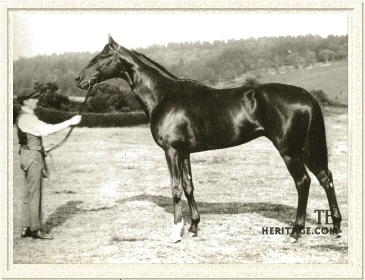 |
|
|
Polymelus was a good race horse and later became the most fashionable and successful stallion of his time, five times leading sire in England, second twice, and third once.
Polymelus was bred by the Earl of Crewe, the son-in-law of the Earl of Rosebery. He was sired by Cyllene, a young stallion by the Two Thousand Guineas winner by Bona Vista and out of the Isonomy mare Arcadia. Deemed too immature to run in the classics, Cyllene nevertheless was a top class horse, and counted the Ascot Gold Cup among his nine victories in eleven starts. But when he went to stud, he was not popular, and even siring an Epsom Derby winner (Cicero, in 1905) did not prevent his sale to Argentina in the summer of 1908. That the British made a mistake in letting him go was illustrated when three more Derby champions emerged after his departure, and he sired four more classic winners in Argentina.
In his second season at stud, Cyllene covered a mare named Maid Marian, a mare bred by Queen Victoria and sold as a yearling at the annual Hampton Court yearling sale. She was by Hampton out of Quiver, by Toxophilite. At the time, this pedigree was not particularly fashionable, as Hampton was an unproven stallion, and Quiver had not yet produced anything of any merit. Consequently, Maid Marian sold for only 400 guineas to a Mr. Lawson. She raced in his colors as a two-year-old--her only season on the racecourse. She ran seven times and failed to notch a single victory. Her last race was a claiming affair, and she went to Richard Marsh for just £150. He made a nice profit by reselling her less than a week later to Francis Luscombe for £300. Her first foal was born in 1890--the same year her half-sister Memoir, by St. Simon, won the Oaks and St. Leger. After Memoir's victory in the latter classic, Maid Marian's value went up considerably, and the filly who could not win a race was sold to Major J.E. Platt for £3000. A couple of years later, her half-sister, La Fleche, also by St. Simon, captured the One Thousand Guineas, Oaks, St. Leger, and later, the Ascot Gold Cup.
Maid Marian did not produce anything of note for Major Platt, except the Galopin horse Grafton, who was unraced but did well as a stallion in Australia. So Maid Marian went through the sales ring at the Newmarket July Sales and was purchased by the Earl of Crewe for 620 guineas. This was quite a bit less than her earlier price of £3000, but Lord Crewe was apparently unconcerned by her uninspiring production record. Her sire, Hampton, had by this time sired two Derby winners and had been the broodmare sire of two more--Ayrshire and Persimmon. This, in addition to her half-sisters' accomplishments made her a bargain to Lord Crewe.
For Lord Crewe, Maid Marian foaled the good Kendal colt Ercildoune, which went on to capture the Duke of York Stakes, and then, in 1901, she was sent to be covered by Cyllene. The produce of this mating, a robust bay colt arrived in 1902. As his sire had been named for the mountain in Greece which had been the birthplace of the mythological god Hermes, so also was the colt by Cyllene-Maid Marian given a name plucked from the ancient myths. He was called Polymelus, after one of the Trojan warriors killed by Patroclus in Homer's The Iliad.
The colt Cicero, also in Cyllene's second crop of 1902, was bred by Lord Crewe's father-in-law, the Earl of Rosebery. Both Cicero and Polymelus were bred along similar lines--Cicero was out of Gas, a daughter of Hampton's son Ayrshire, while Polymelus was out of a daughter of Hampton. Cicero went on to capture the Derby Stakes and Polymelus, though not of that exalted class, was nevertheless a durable and honest campaigner who won several important races and placed second in the classic St. Leger, finishing ahead of Cicero in the process.
Polymelus on the Turf
A handsome, well-built colt, Polymelus was sent to the yard of venerable trainer John Porter as a yearling. As a two-year-old, Polymelus made eight starts and won three. Having worked well at home, he was confidently expected to win his debut, a Triennial Stakes at Ascot, but he disappointed by running second. Jumped in class for his next start, the National Breeders' Produce Plate at Kempton Park, Polymelus ran unplaced to Cicero. Polymelus redeemed himself at Goodwood by winning the Richmond Stakes, and then capturing both the Rous Memorial Stakes and Criterion Stakes at Newmarket in the autumn. But in some of the more important races for juveniles, he did not fare well, as he was unplaced in both the Middle Park Plate and the Imperial Plate and then ran second in the Convivial Stakes at York. He was a long way from being the best two-year-old of his year, that honor accorded to Cicero, who in addition to his trouncing of Polymelus in the National Breeders' Produce Stakes, had easily captured the July Stakes, Fitzwilliam Stakes, Woodcote Stakes, and Coventry Stakes.
|
Polymelus' Race Record
|
| Year |
Age |
Starts |
1st |
2nd |
3rd |
Unpl |
Earnings |
| 1904 |
2 |
8 |
3 |
2 |
0 |
3 |
£2,353 |
| 1905 |
3 |
11 |
4 |
3 |
1 |
3 |
£5,685 |
| 1906 |
4 |
10 |
3 |
2 |
0 |
5 |
£3,925 |
| 1907 |
5 |
2 |
1 |
0 |
1 |
0 |
£4,840 |
| Total |
-- |
31 |
11 |
7 |
2 |
11 |
£16,803 |
| |
At three, Polymelus came out for the Newmarket Stakes, but finished a non-threatening fifth to Cicero, Llangibby, and Signorino. This lackluster performance was enough to convince Lord Crewe and Porter that it would be futile to run against Cicero and the top French colt, Jardy, in the Derby, and their decision proved well-founded when those two colts finished one-two in the Epsom classic. Polymelus was reserved for Royal Ascot, where he finished a good second to Oaks heroine Cherry Lass in the St. James Palace Stakes and then the next day, won the Triennial Stakes over Llangibby, the strong favorite for the race.
|
Polymelus met Llangibby and Cicero again in the semi-classic Eclipse Stakes at Sandown Park, but could only manage fourth to French invader Val d'Or, with Cicero second and Llangibby third, Polymelus carrying six pounds fewer than Cicero and three fewer than Val d'Or and Llangibby. The next start for Polymelus resulted in a third place finish in the Stewards' Cup at Goodwood, a precursor to a well deserved victory in the Durham Produce Plate at Stockton, run over 1-1/4 miles in which Polymelus toted 10 to 28 pounds more than his rivals. He notched his second victory in a row when he captured the Duke of York Stakes at York. A loss in the Preveril of the Peak Handicap at Derby followed, but it was obvious, despite this loss, that the colt was steadily improving, and so a shot in the last of the classics, the 1-3/4 mile St. Leger was accorded to him.
Polymelus did not disappoint. He did not win, but he ran very well, for he finished a fine second to Challacombe, and in front of Cherry Lass and Llangibby. He turned in another fine performance in the Jockey Club Stakes at Newmarket a short while later. Polymelus ran the older St. Amant, winner of the previous year's Derby, to less than a length, with the heavy favorite for the race, the French crack Gouvernant, behind him. Polymelus closed out his busy three-year-old campaign with a victory in the Gatwick Stakes, then a race of some importance.
With this victory, Polymelus became the last winner saddled by the legendary John Porter. The man who had trained such stalwarts as Shotover, St. Blaise, Ormonde, Sainfoin, Common, Orme, and Flying Fox, retired. With Porter's patience and skill at bringing out the best in his charges, and the fact that Polymelus was getting better with maturity, leads one to wonder how good he might have become had he enjoyed the services of Porter throughout his career. It was not to be. With Porter's retirement, Lord Crewe decided to sell Polymelus, and the horse went to David Faber for £3000 and sent to a Mr. Baker to be trained.
Polymelus at four was not nearly as effective as he had been in the latter part of his three-year-old season. He made ten starts, won only three and was five times unplaced. He began with an unplaced run in the City and Suburban Handicap, a second in a Triennial, unplaced in the important Rous Memorial Stakes, unplaced to Dinneford, Llangibby, and St. Amant in the Princess of Wales Stakes at Newmarket, and unplaced in the Eclipse Stakes won by Llangibby. Polymelus finally looked like regaining some form with his next performance, a second in the Prince of Wales Handicap to Aurina.
Clearly, Mr. Baker was not able to win with Polymelus, and David Faber decided to transfer his horse to Frank Hartigan's yard at Weyhill. In an unusual move, Faber included Polymelus in the Newmarket First October Sale, and Hartigan was instructed to bid up to 4000 guineas for the horse. Not surprisingly, Faber lost the horse. Attending the sale was Solomon Barnato Joel, brother of Jack Joel. These brothers had made their fortune helping their uncle, Barney Barnato, in South Africa. Barnato had helped found the DeBeers Consolidated Mines in partnership with Cecil Rhodes. Later, Barnato made an additional fortune in gold mining. The brothers invested in their uncle's financial empire, and enjoyed a considerable inheritance when their uncle died by suicide in 1897. Solly and Jack Joel returned to England, where the former founded Maiden Erlegh Stud, and the latter Childwick Bury.
Solomon, or Solly as he was known, was looking for a nice stallion prospect, and the fact that Polymelus was engaged in some important races, was an added element of appeal. Joel drove the price up to 3800 guineas. The latter, unsure of what to do, bid another hundred, and for a few seconds, it seemed as if Faber would keep his horse. However, the auctioneer, Mr. Tattersall, was unwilling to let the horse go for 3900 guineas. He turned to Solly Joel and commented that the horse was engaged in the important Jockey Club Stakes. Tattersall went on to point out, "And then he is in the Duke of York Stakes at Kempton, which, on his running in the Prince Edward Handicap, he looks like winning." Joel replied, "Yes, but they won't let you bet on him." To which Tattersall quickly responded, "Very well, but Polymelus is also in the Cambridgeshire, which he may win and you can bet as much as you like on that race." The result was that Joel raised his bid to 4200 guineas, leaving a dejected Hartigan to walk away, having lost the horse before he ever got to officially train him.
Polymelus finished fourth in the Jockey Club Stakes, but then went on to score very impressive victories in both the Duke of York Stakes and the Cambridgeshire Handicap. Three days after the latter race, Polymelus won the important Champion Stakes at Newmarket.
Kept in training as a five-year-old, he made only two starts, finishing third in the Coronation Cup at Epsom to The White Knight and Troutbeck, and then winning the Princess of Wales Stakes. All told, Polymelus won 11 of his 31 starts.
Polymelus in the Stud
Polymelus was never considered in the same class as the classic winners of his generation. At stud, it was a different story, for he became the most successful British stallion of his era. Unlike his sire, Cyllene, who was sold to the Argentine for stud duty, Polymelus stood his entire life as a stallion at Solly Joel's Maiden Erlegh Stud, near Reading, in Berkshire. Like his sire before him, Polymelus consistently sired high class runners. An initial stud fee of 98 guineas rose to 300 guineas. He was champion sire in Britain on five occasions: 1914-1916 and 1920-1921. Five classic winners were sired by Polymelus: Black Jester; Triple Crown winner Pommern; Derby and Oaks heroine Fifinella; One Thousand Guineas victress Cinna; and the ill-fated Derby hero Humorist. |
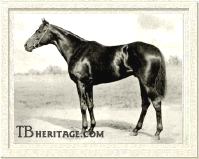
Black Jester
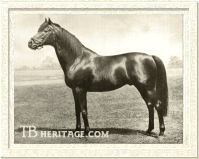
Pommern
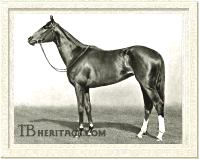
Fifinella
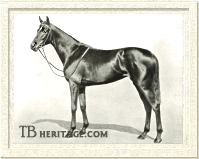
Cinna
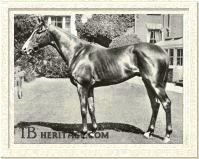
Humorist
| |
BLACK JESTER, out of Absurdity, by Melton, might have had a more glorious racing career had not his temperament been such a problem. Raced by Jack Joel, the colt captured the Richmond Stakes and Molecomb Stakes at two, and the Sussex Stakes, St. George Stakes, the Ascot Biennial Stakes and the St. Leger at three. That season, he was also second in the Champion Stakes and Princess of Wales Stakes and third in the Two Thousand Guineas. He was not a success at stud, getting few winners, however he sired some good producing daughters: Black Ray produced the top two-year-old Jacopo, the good runner Foray, and Eclair, a top three year old race filly and dam of Khaled; Black Domino produced the good French race horse, Barneveldt (winner of the Grand Prix de Paris, among others); Midnight Folly, dam of French 2,000 Guineas winner Drap d'Or; Schwarze Kutte, dam of two good stakes winners in Germany, and Smoke Lass, dam of the dual Irish classic winner Smokeless.
POMMERN, foaled in 1912 from the St. Hiliare mare Merry Agnes, captured a wartime Triple Crown of the Two Thousand Guineas, the New Derby, and the September Stakes, all run at Newmarket. The colt was bred and raced by Solly Joel, and upon his retirement, was sent to stand alongside his sire at Maiden Erlegh Stud. Pommern commanded a 300 guinea stud fee, but he was a disappointment as a stallion, his best offspring being Two Thousand Guineas champion Adam's Apple.
FIFINELLA, a chestnut daughter of Polymelus from the mare Silver Fowl, by Wildfowler, captured the Derby in 1916, the year after Pommern. Bred and owned by Sir Edward Hulton and trained by Dick Dawson at Newmarket, Fifinella was another offspring of Polymelus with a disagreeable temperament.
Described by her trainer as catty and peevish, she failed to endear herself to her trainer or the lads who had charge of her. She did get along with jockey Steve Donoghue, and as a juvenile, won two of her three starts under him, including the important Cheveley Park Stakes. He was unavailable to ride her at three, and she was partnered by Joe Childs, who had no inclination to humor a moody filly, as evidenced by their race in the One Thousand Guineas. Fifinella acted up badly at the start, and for her antics, received a sharp reminder with Childs' whip. The filly consequently sulked and refused to run her best. She lost to Lord Derby's filly Canyon.
Sent after the Derby, Fifinella ran erratically throughout, but finally got up to beat Kwang-su, a half brother to classic winners Bayardo and Lemberg, by a neck. Two days later, Fifinella gave no trouble to Childs and ran a flawless race in the Oaks. A third place finish later in the autumn to another Polymelus offspring, Phalaris, was her last outing. At stud, she was something of a disappointment, for her best was the Hurry On colt Press Gang, winner of the Middle Park Plate and the Princess of Wales Stakes. Press Gang was sent to stud in France, but he wound up in Russia. Many of Fifinella's offspring inherited their dam's unpredictable temper, which made them difficult to train, though eight of her foals were winners.
CINNA, out of Baroness La Fleche, by Ladas, second dam La Fleche, was an interesting example of inbreeding: Maid Marian, the dam of Polymelus, was a half sister to La Fleche. Cinna captured the One Thousand Guineas and the Coronation Stakes, and placed second in the Oaks. As a broodmare, her most important offspring was her minor stakes-winning son, Beau Pere, by Son-in-Law.
|
Winner of three races in eleven starts at three and four, Beau Pere was sent to stud in New Zealand, where he led the sire list from 1938-1940, and was leading sire of two-year-olds the first season they hit New Zealand tracks. Transferred to Australia, Beau Pere led the sire list there for three consecutive years. The stallion was then purchased by Louis B. Mayer and shipped to California, and later, to Spendthrift Farm near Lexington, Kentucky. He was the sire of such standouts as Bridal Flower and Honeymoon and was the broodmare sire of Kentucky Derby champion Swaps. Two more of Cinna's sons, Buckler and Mr. Standfast, also made decent names for themselves as sires in Australia.
Humorist
The last classic winner sired by Polymelus was the tragic HUMORIST, winner of the Derby in 1921. Bred by Jack Joel, Humorist was out of Jest, a half-sister, by Sundridge, to Black Jester. Like Black Jester, Jest was an animal of unpredictable temperament but classic ability. She captured both the One Thousand Guineas and the Oaks in 1913 and then retired to the broodmare ranks at her owner's Childwick Bury Stud. Humorist was her first live foal, though throughout his short life he suffered from delicate health. A handsome chestnut colt with a broad blaze, Humorist was blessed with a temperament totally opposite that of his dam and near relative Black Jester--he was kind and intelligent and adored by everyone who dealt with him.
Sent to the yard of trainer Charles Morton at Wantage, in Berkshire, Humorist soon gave evidence that he was a colt of exceptional ability. He was scheduled to start his career in the Woodcote Stakes at Epsom, but shortly before the race, became listless and went off his feed. There was no apparent reason for Humorist's illness, and he recovered quickly enough. In the race itself, he looked on his way to an easy victory when he suddenly slowed and only won by a neck. The colt's health problems persisted, and engagements at Royal Ascot had to be abandoned when Humorist began to suffer a bout of coughing that did not plague any other members of the stable. Morton recalled, "I knew him to be at least a stone in front of the other two-year-olds, but all the time I felt there was something wrong with him. It continually puzzled me why he would be perfectly well one day and listless the next."
The Champagne Stakes at Doncaster was the next target for Joel's colt, and though he had seemingly recovered from his cough, he suffered a neck defeat by Lemonora. Humorist then comfortably won both the Buckenham Stakes and the Clearwell Stakes at Newmarket, displaying the brilliant form his connections were confident he possessed. The important Middle Park Plate was his next engagement, and Humorist was not disgraced, losing a gallantly run race by only a neck to a colt named Monarch.
Humorist went into winter quarters as the favorite for the next season's classics, and to the relief of his trainer, seemed to do well over the winter. He trained forwardly for his first engagement of the season, the Two Thousand Guineas at Newmarket. The Morton stable was confident of Humorist, and indeed, the colt looked to have the race won. But upon reaching the rising ground in the straight to the finish, once again Humorist faltered. Craig-an-Eran and Lemonora both passed him, with Craig-an-Eran, owned by Major Waldorf Astor, a victor by three-quarters of a length over Lemonora, who held the same margin over an exhausted Humorist.
In the Derby, partnered by Steve Donoghue, Humorist gave a heroic performance. Donoghue guided the colt to the rails just behind the leaders and held that position, galloping easily until past Tattenham Corner, when he asked Humorist to move into the lead. Humorist responded willingly to his jockey and set sail along the straight for home. He was soon challenged by Craig-an-Eran, and Humorist had to fight for his victory. The Astor colt drew even, but Humorist dug in and fought bravely to win the classic by a neck. Humorist's effort in the Derby left him so weak and exhausted after the race that he trembled in the winner's enclosure. His trainer made arrangements to stable him at Epsom overnight and then took him home to Wantage the next day. No one knew it then, but the public had seen the last of Humorist on the racecourse.
Less than three weeks later, Humorist was dead. The colt suffered some bleeding from his nostrils while training for Royal Ascot and was returned home to his trainer's yard at Wantage for a rest. On a sunny Sunday afternoon, after posing for artist Alfred Munnings, Humorist was discovered dead in his box, blood flowing from under his prostrate body. Blood around the walls of the box showed how the poor colt had wheeled around desperately in search of oxygen before he collapsed with his nose at the bottom of the stall door. An autopsy revealed that the colt suffered from a tubercular lung condition and died from a massive lung hemmorrhage. Humorist was buried in the stableyard of Childwick Bury, his grave marked with a large stone marker and urn filled with geraniums. The marker can still be seen today, usually adorned with geraniums and is located near the graves of Sundridge, Sunstar, Doris, and his own dam, Jest.
Other Polymelus Progeny
|
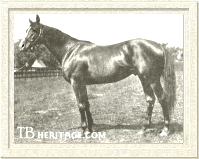
Archaic
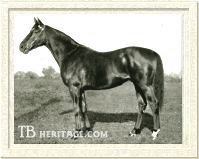
Parth
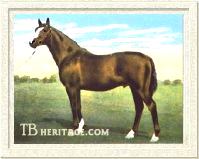
Polymelian | | Polymelus sired several winners which placed in the English classics: MAIDEN ERLEGH out of Plum Tart, by Persimmon, placed second in the St. Leger. This horse was purchased by Arthur Hancock during World War I to serve stud duty at his newly-formed Claiborne Farm near Lexington, Kentucky. Sadly, the young stallion never reached his destination, as the ship on which he was being transported was torpedoed and sunk by a German U-boat off the Irish coast.
CORCYRA, out of Pearmain, by Persimmon, ran second in the Two Thousand Guineas and was sent to the United States for stud duty. He avoided the fate of Maiden Erlegh and landed safely in the States, the champion filly Cleopatra being his best representative.
DOMINION, out of Osyrua, by Desmond, ran third in the Two Thousand Guineas and second in the St. Leger.
The filly GLACIALE, out of Glacier, by St. Simon, notched a third place finish in the 1919 One Thousand Guineas.
ARCHAIC, out of Keystone II, by Persimmon, ran second to Spion Kop in the 1920 Derby, while SILVERN, a full brother to Fifinella, ran second in the St. Leger and the next year took the Coronation Cup.
CRAIGANGOWER, out of Fortuna, by Spearmint, placed second to Captain Cuttle in the Derby of 1922 and PARTH, out of Willia, by William the Third, ran third to Papyrus in the Derby one year later and later that season captured the Prix de l'Arc de Triomphe.
The last classic-placed performer by Polymelus was POLYPHONTES, out of St. Josephine, by St. Denis. He was a good third to Salmon Trout in the St. Leger in 1924 and was also a dual winner of the Eclipse Stakes.
Polymelus also was responsible for an American classic winner, when his son, WAR CLOUD, out of Dreamy II, by Persimmon, captured the 1918 Preakness Stakes, ran second in the Belmont Stakes and third in the Travers Stakes. War Cloud's best offspring was the filly Nimba, victress in the Coaching Club American Oaks, the Alabama Stakes, Lawrence Realization, and Metropolitan Handicap.
|
Polymelus was the sire of many other major winners, including the filly BENEVENTE , a full sister to Corcyra and, like her brother, a winner of the Middle Park Plate. Several other offspring of Polymelus performed admirably in other countries. War Cloud has been mentioned, but Polymelus also sired POMME DE TERRE, who, in addition to his wins in the Manchester Cup and Great Yorkshire Stakes captured the Grand Prix de Saint Cloud and Prix du President de la Republique in France. TRAUM was a fine winner in Germany, counting the Grosser Preis von Berlin and the Grosser Preis von Hamburg among his stakes tallies. CHANTEMERLE and POLYCRATES won races in Australia and POLYCHROMY and POLYSTOME won in South Africa; Polystome was leading sire in South Africa eleven times.
POLYMELIAN, out of the Sundridge mare Pasquita, was a minor winner for his sire, his biggest win coming in the Luzern Highweight Handicap. Exported to the United States for stud duty, his blood has lived on. The sire of twenty stakes winners, he is best known for his son Caruso, sire of the influential broodmare Imperatrice, second dam of Sir Gaylord and Secretariat. Black Polly, a daughter of Polymelian, became the dam of Preakness Stakes champion Polynesian, sire of dual classic winner and internationally influential sire, Native Dancer. |
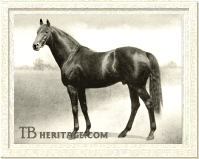
Phalaris | |
But perhaps the best known horse of the progeny of Polymelus was his son PHALARIS, who was only an average racer but a stallion par excellence, as he was responsible for establishing the male line of his sire as the most dominant one in Europe and later, the United States, a fact that holds true to this day. Phalaris was bred by the Earl of Derby, who had purchased his dam, the Sainfoin mare Bromus, from the dispersal of J. H. Houldsworth. She had been a moderate runner, but she was by a Derby winner out of a St. Simon mare, so she had a fine pedigree. Her son Phalaris was foaled in 1913. |
Trained by George Lambton, Phalaris captured 16 races in 24 starts from ages two through five. Phalaris was a speedy horse, but not up classic standard, as he finished unplaced in the Two Thousand Guineas, his only venture in the classics. Phalaris won such events as the Bretby Handicap, Beaufort Stakes, Bury St. Edmunds Plate, Snailwell Stakes, and the July Stakes. Following his retirement from the turf, Lord Derby offered him for sale for £5000, but he went unsold, so Lord Derby installed him alongside Chaucer and Swynford, the premier sires at the Derby stud.
Phalaris went on to lead the sire list in 1925 and 1928, and he came up with five classic winners: Chatelaine, winner of the Oaks; Fairway, winner of the St. Leger, Eclipse Stakes, Jockey Club Cup, and twice the Champion Stakes; Fair Isle, winner of the One Thousand Guineas; Colorado, a winner of the Two Thousand Guineas, Eclipse Stakes, Princess of Wales Stakes who also placed third in the Derby; and Manna, winner of the Two Thousand Guineas and Derby. Another son of Phalaris, Pharos, placed third to Papyrus in the Derby of 1923. Probably not surprising, given that Phalaris stood alongside Chaucer, three of his classic winners were out of Chaucer mares--Fair Isle, Fairway, and Colorado.
Other top class runners by Phalaris included Caerleon, a winner of the Eclipse Stakes and a full brother to Colorado; Pharamond, winner of the Middle Park Stakes, and Sickle, third in the Two Thousand Guineas. These last two were each imported to the United States for stud duty, where both became influential sires. Likewise, in England, Pharos and Fairway became influential stallions, and from these four sons of Phalaris, grandsons of Polymelus, have sprung male lines which have included the likes of Nearco, Nasrullah, Royal Charger, Bold Ruler, Nashua, Fair Trial, Court Martial, Grey Sovereign, Raise a Native, Alydar, Mr. Prospector, Northern Dancer, Secretariat, Seattle Slew, Affirmed, Sadler's Wells--to name only a few. Phalaris died in 1931 at the age of 18.
For all the success Polymelus enjoyed as a stallion, it was a fact that his colts were judged superior to his fillies on the race track. It proved so, too, at stud. Polymelus mares were not as prized as his sons as breeding stock. The best horse produced from a Polymelus daughter was Polemarch, by The Tetrarch. The dam of Polemarch, POMACE, was out of Pearmain, by Persimmon, and thus a full sister to Benevente and Corcyra. Despite being sired by The Tetrarch, an unbeaten two-year-old with blazing speed, Polemarch was a stayer and captured the 1-3/4 mile St. Leger as his biggest victory. Exported to stand in Argentina, Polemarch became a very good sire there, his best get being the champion filly Fe Ciega, a stunning chestnut with a flaxen mane and tail who was victorious in the Gran Premio Seleccion, the Argentine version of the classic Oaks.
Cecil, a Foxlaw colt which captured the Coronation Cup and placed second in the Ascot Gold Cup, was produced from the Polymelus daughter STAR OF BLYTH.
Through Lord Astor's mare PLYMSTOCK, (out of Winkipop, by William the Third), Polymelus became the broodmare sire of Pennycomequick (by Hurry On), winner of the Oaks and granddam of Kentucky Derby and Preakness champion Pensive. Pennycomequick's half sister, Sunny Devon, by Solario, was named champion three-year-old filly in England in 1931, while another half sister, Alpenstock III, by Apelle, was imported to the United States and later named a Broodmare of the Year. At the age of 21, Lord Astor sent Plymstock to Germany to be covered by Oleander. The result was a small, weedy colt named Pink Flower. Nearly sent to the slaughterhouse because he was considered such a runt, the colt won a reprieve and was purchased by a Captain Gillson, in whose colors he nearly won the Two Thousand Guineas, being beaten by just inches by Kingsway in the 1943 running.
The great racemare Pretty Polly visited the court of Polymelus at Maiden Erlegh and eleven months later dropped the filly POLLY FLINDERS. This filly resembled her dam in appearance and also inherited some of Pretty Polly's ability as a racer. Polly Flinders at two captured the National Breeders' Produce Stakes, as her dam had done, and also placed second in the Champion Breeders' Foal Plate. She failed to train on at three, running unplaced three times, and she was retired to Eyrefield Lodge to join her mother in the broodmare paddocks. Polly Flinders bred nine fillies, the best of which was Arabella, by Buchan. This filly won the Queen Mary Stakes, Imperial Produce Stakes, and Champagne Stakes. Polly Flinders, chiefly through this daughter, founded a branch of the Pretty Polly family which has included classic winners Sea Symphony, The Cobbler, Only For Life, and Unite, plus major winners such as Supreme Court, Arctic Explorer, Follow Suit, and Marwell, to name but a few. Pretty Polly also threw the colt Passchendaele to Polymelus. Unable to earn a placing as a juvenile, he was sold and sent to Belgium for stud duty.
Several mares by Polymelus were safely shipped across the Atlantic during the height of World War I, and some dropped foals which went on to become top class American racers. The mare ROMAGNE became the dam of a Sun Briar colt named Sunny Man, a top two-year-old of 1924 when he won the United States Hotel Stakes, the Whirl Stakes, and the Saratoga Special, in addition to placing third in the Grand Union Hotel Stakes. His half-sister, Aromagne, by Allumeur, was one of the better fillies of 1926, when she captured the Schuylerville Stakes and ran second in the Selima Stakes. Another imported daughter of Polymelus, POLISTENA, foaled the tough General Thatcher, a colt by Sweep. General Thatcher won two runnings of the Frontier Handicap, the Pimlico Spring Handicap, placed second in the classic Preakness Stakes, as well as the Coffroth Handicap, Illinois Derby, Toronto Cup, Walden Handicap, and Hindoo Handicap. The Polymelus mare SOBRANJE was the dam of the gritty The Porter colt Stepenfetchit, winner of the Latonia Derby and Dixie Handicap, and third place finisher to Burgoo King in the 1932 Kentucky Derby.
An interesting facet to the stud career of Polymelus was the number of top class runners he sired which were out of daughters of Persimmon. Maiden Erlegh, Corcyra, War Cloud, Benevente, and Archaic were the most notable. Since Polymelus and Persimmon were out of mares by Hampton, this gave these runners inbreeding to Hampton in the third and fourth generation of their pedigrees. The aforementioned Polemarch was out of Pomace, a full sister to Benevente and Corcyra. And finally, though not out of a Persimmon mare, it is interesting to note that the dam of Polymelus' son Polyphontes was out of a mare by Royal Hampton, by Hampton. Clearly, there was a strong affinity between these bloodlines.
All told, Polymelus sired over 50 individual winners of £1000 and up, nearly 220 winners of over £240,000, and progeny of his daughters earned over £70,000. Not only was he a popular stallion because of his outstanding success in siring high class winners, he also provided a valuable outcross to mares with the blood of Galopin and St. Simon coursing through their veins, for he had absolutely no Galopin or St. Simon blood in his pedigree.
During his first season at Maiden Erlegh, Polymelus suffered an accident when he fell over and severely injured his pelvis. From then on, he required help to mount his mares. This old injury, plus years of suffering from rheumatism, led to the decision to humanely put him down at the age of 22 on March 24, 1924. He was buried at Maiden Erlegh. His sire, Cyllene, outlived him by nearly a year, dying at age 29.
--Liz Martiniak |
|
|
|

